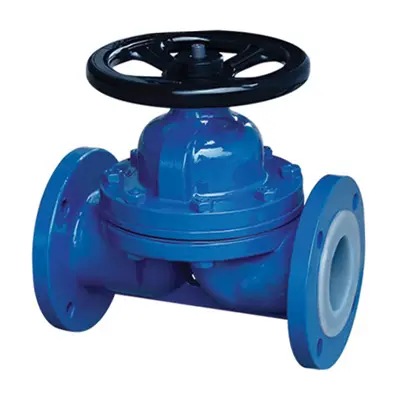Diaphragm Valve Manufacturer in Ahmedabad
Diaphragm valves manufactured by us are highly demanded in various industries, including agriculture, chemical processing, bio-pharmaceuticals, energy production, mining, plumbing, pulp and paper, food processing, irrigation, medicine, and water treatment. The fundamental construction of the diaphragm valve is very simple. These Diaphragm valves are composed of three principal units: Body, Bonnet, and Diaphragm. Our diaphragm valves are manufactured using high-quality raw materials and in compliance with international standards. Diaphragm valves are mainly used in industries handling Abrasives, Corrosive, Viscous, or Fibrous Fluids.
There are numerous combinations available for selecting the most suitable body material, body lining and diaphragm material for a specific service depends on several variables, economic considerations nature of fluid handled, its concentration and cohesiveness, temperature, pressure, velocity and continuity of flow. Diaphragm life depends not only upon the nature of the fluid handled but also upon the temperature, pressure and frequency of operations. These Valves can be effectively used to handle Pharmaceuticals, Foods, Dairy Products, as well as Beverages & Water Treatment Plants.

Diaphragm Valve Specifications:
| Sizes | DN15 to DN300 |
| Pressure Rating | Class 150 & 300 |
| Material Construction | Ductile Iron – Grey Cast Iron, S.G. Iron, etc. Cast Carbon Steel – WCB, WCC, etc. Austenitic Stainless Steel – CF8, CF8M, CF3, CF3M, etc. Other Material – As per client Requirement |
| Design & Manufacturing Standard | BS 5156 |
| Face to Face Std. | ASME B16.10 |
| End Connection Std. | Flanged to ASME B16.5, BS Standard, DIN Standard, Screwed Ends, Socket Weld Ends, But Weld, etc… |
| Testing Standard | API 598 / BS 6755 Part-I |
| Structure Type | Weir Type / Straight Way |
| Construction Lined | Lined – Ebonite, EPDM, Neoprene, Natural Rubber, White Natural Rubber, Hypalon, Black Butyl, White Butyl, Buna N. Un-Lined |
| Diaphragm | Neoprene, EPDM, Natural Rubber, Hypalon, Butyl, Buna N, PTFE Lined |
| Operated Type | Hand wheel, Pneumatic Cylinder, etc. |
Diaphragm Check Valves and Diaphragm Control Valves
Diaphragm valves are separated into two major categories: diaphragm check valves and diaphragm control valves.
Diaphragm check valves ensure materials flow unidirectional by employing a flexible membrane diaphragm.
Diaphragm control valves allow manufacturers to modify pressure, temperature flow rates, and liquid levels as they go along. They do so with the assistance of a diaphragm made of an elastomer film or membrane.
Seat Valves and Saddle Valves
In turn, check valves and control valves are further divided into two configuration groups: seat valves and saddle valves, or straight-way and weir valves, respectively.
Both of these valve types feature two or more ports through which materials flow. With both, one port serves as an inlet and at least one other serves as a place for exhaust to escape from the body. When the valve is not engaged, materials will simply flow in one port and out the other, but when it is, flow becomes restricted or completely repressed.
The main difference between seat valves and saddle valves deals with the alignment of their ports.
Seat valve bodies use a 90° bend to cause the directional change of a process stream as it moves around a corner. Essentially, seat valves create a nonlinear stream path. Most often, seat valves are used to facilitate angled flow in cistern or tank bottoms.
Saddle valves, on the other hand, direct flow with two ports that are located opposite one another. Essentially, saddle valves create and regulate a linear stream path. Typically, they assist pre-existing flow lines.
Aside from the difference in piping or tubing angle, seat valves and saddle valves are essentially the same. To begin with, they both consist of a spherical or cylindrical body, attached to the tubing or tank that requires the valve, which contains the actuation device and diaphragm. They both also have the same type of diaphragm. The diaphragm of both is thin at the edges and thick in the middle, a feature that permits easy stretching. It lifts up when the valve is opened, allowing for gases or fluids to pass. When the valve is closed, the stem engages the diaphragm by applying pressure. This pressure forces the diaphragm to move towards the opposite wall of the piping to create a flexible but effective flow barrier.
